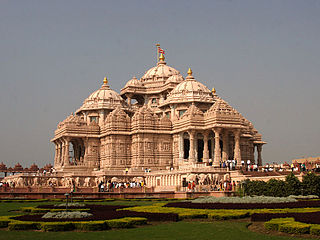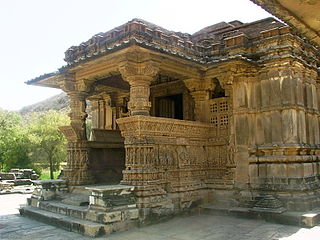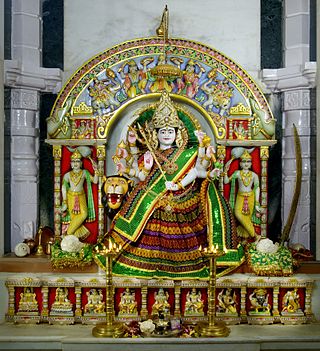
BAPS Shri Swaminarayan Mandir is a Hindu temple in Neasden, London, England. Built entirely using traditional methods and materials, the Swaminarayan mandir has been described as being Britain's first authentic Hindu temple. It was also Europe's first traditional Hindu stone temple, as distinct from converted secular buildings. It is a part of the Bochasanwasi Shri Akshar Purushottam Swaminarayan Sanstha (BAPS) organisation and was inaugurated in 1995 by Pramukh Swami Maharaj. The temple complex also consists of a permanent exhibition entitled "Understanding Hinduism" and a cultural centre housing an assembly hall, gymnasium, bookshop, and offices.

Somnath temple or Deo Patan, is a Hindu temple, located in Prabhas Patan, Veraval in Gujarat, India. It is one of the most sacred pilgrimage sites the Tirtha Kshetra for Hindus and is the first among the twelve jyotirlinga shrines of Shiva. It is unclear when the first version of the Somnath temple was built, with estimates varying between the early centuries of the 1st millennium and about the 9th century CE. Various texts, including the Mahabharata and Bhagavata Purana, mention a tirtha at Prabhas Patan on the coastline of Saurashtra, where the later temple was, but archaeology has not found traces of an early temple, though there was a settlement there.
Wadhwan, also spelled Vadhwan, is a city and a municipality in Surendranagar district in the Indian state of Gujarat. Located on the banks of the Bhogavo River, around 3 km from Surendranagar and 111 km from Ahmedabad, Wadhwan is a known location for its old world royal charm and serene space with a life and culture of its own. It was historically the capital of Wadhwan State.
Prabhas Patan, historically named Dev Patan, is a locality in Veraval, Gujarat. As the site of the Somnath temple and its associated Jyotirlinga, it is an important place of Hindu pilgrimage.

Swaminarayan Akshardham is a Hindu temple and spiritual-cultural campus in Delhi, India. The temple is close to the border with Noida. Also referred to as Akshardham Temple or Akshardham Delhi, the complex displays millennia of traditional and modern Hindu culture, spirituality, and architecture. Inspired by Yogiji Maharaj and created by Pramukh Swami Maharaj, it was constructed by BAPS. It is the world's second-largest BAPS Hindu temple, following Akshardham, New Jersey, in the United States.
Dhrangadhra is a town, taluka headquarters and a municipality in Surendranagar district in the state of Gujarat, India. During the period of the British Raj, the city was the capital of Dhrangadhra State, one of the eight first-class princely states of the Kathiawar Agency in the Bombay Presidency.

Swaminarayan Akshardham in Gandhinagar, Gujarat, India is a large Hindu temple complex inspired by Yogiji Maharaj (1892–1971) the fourth spiritual successor of Swaminarayan, and created by Pramukh Swami Maharaj (1921–2016), the fifth spiritual successor of Swaminarayan according to the BAPS denomination of Swaminarayan Hinduism. Located in the capital of Gujarat, the complex was built over 13 years and is a tribute to Swaminarayan and his life and teachings. At the center of the 23-acre complex is the Akshardham mandir, which is built from 6,000 metric tons of pink sandstone from Rajasthan. The complex's name refers to the divine abode of Swaminarayan in the BAPS philosophy; followers of Swaminarayan believe that the jiva or soul goes to Akshardham after attaining moksha, or liberation. BAPS followers worship Swaminarayan as God almighty.

A Jain temple, Derasar or Basadi is the place of worship for Jains, the followers of Jainism. Jain architecture is essentially restricted to temples and monasteries, and Jain buildings generally reflect the prevailing style of the place and time they were built.

The architecture of the Indian state of Rajasthan has usually been a regional variant of the style of Indian architecture prevailing in north India at the time. Rajasthan is especially notable for the forts and palaces of the many Rajput rulers, which are popular tourist attractions.

Dhari is a town in Amreli District in Indian state of Gujarat, India. It is an administrative headquarter of the Dhari tehsil(almost 87 villages and ness).Dhari is the most populous town in Amreli District as per census 2011 with 30352 population. Dhari is located on the bank of Shetrunji River, 42 km(26.2 mi) from district headquarter Amreli & 318 km(199.8 mi) from state capital Gandhinagar. Dhari is famous for kesar mango and Asiatic lion. Dhari is capital of East Gir Forest.

The Paramara Dynasty was an Indian dynasty that ruled Malwa and surrounding areas in west-central India between 9th and 14th centuries. They belonged to the Paramara clan of the Rajputs.
The Sompura Brahmin are a Hindu caste found in the state of Gujarat and Rajasthan in India. They are a sub-group of the Brahmin community.

Ashapura Mata is an aspect of Devi, a Hindu goddess. She is one of the kuldevis of Kutch and Rajasthan, and the Jadeja clan of Gujarat, Chauhans and Patiyats inhabiting the western Indian provinces. She is a goddess regarded to fulfill the wishes of her adherents.

The Chaulukya dynasty, also Solanki dynasty, was a dynasty that ruled the Kingdom of Gujarat in western India, between c. 940 CE and c. 1244 CE. Their capital was located at Anahilavada. At times, their rule extended to the Malwa region in present-day Madhya Pradesh. The family is also known as the "Solanki dynasty" in the vernacular literature. They belonged to the Solanki clan of Rajputs.

Māru-Gurjarat architecture or Solaṅkī style, is the style of West Indian temple architecture that originated in Gujarat and Rajasthan from the 11th to 13th centuries, under the Chaulukya dynasty. Although originating as a regional style in Hindu temple architecture, it became especially popular in Jain temples, and mainly under Jain patronage later spread across India, then later to diaspora communities around the world.

Shri Atma Vallabh Jain Smarak also popularly known as Vallabh Smarak Jain Mandir Tirth is a Jain temple and a multi-faceted memorial in the sacred memory of Jain Acharya Shri Vijay Vallabh Surishwer Ji, located on GT Karnal Road, Delhi.

The Ram Mandir is a partially constructed Hindu temple complex in Ayodhya, Uttar Pradesh, India. Many Hindus believe that it is located at the site of Ram Janmabhoomi, the mythical birthplace of Rama, a principal deity of Hinduism. The temple was inaugurated on 22 January 2024 after a prana pratishtha (consecration) ceremony. On the first day of its opening, following the consecration, the temple received a rush of over half a million visitors, and after a month, the number of daily visitors was reported to be between 100,000 and 150,000.
Maa Janaki Janmbhoomi Mandir or Punaura Dham is a proposed grand temple of princess Sita in Mithila at her birthplace. The site is located at the Punaura Dham in Sitamarhi district of Bihar in India. The site is considered as the appearance place from where Sita was found closed in a box from a farm field while the King Janaka was ploughing the farm field. Ramayana Research Council has proposed the construction of the world's tallest 251-feet statue of Mother Sita at Sitamarhi. There is a plan to build Janaki Dham in Sitamarhi on the lines of Ram Mandir in Ayodhya. A grand campus known as Janaki Dham will be built on 57 acres of land near Punauradham. It is expected that the Prime Minister Narendra Modi will laid the foundation stone of the Janaki Dham before upcoming Lok Sabha Election 2024. The foundation stone of the Janaki Janmasthali Mandir was laid by the Chief Minister Nitish Kumar of Bihar on 13 December 2023 at Punauradham in Sitamarhi, the place of manifestation of Goddess Janaki.













